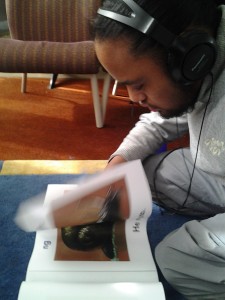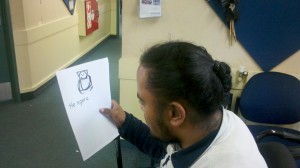This learning story has been translated into Māori as the learning took place in a Māori immersion setting. Translations were done by Tuhoe kaumatua, Nanny Merekui who is a kaimahireo at Te Kura Kaupapa Māori o Ngati Kahungunu o te Wairoa.
Resource Teacher of Vision Kelly Doyle, is working with a sixteen year old Te Kura Kaupapa Māori student at level one of Te Marautanga. Hemi and Kelly are working on Literacy/Alphabet activities using Te Reo Māori and adapted Puoro o Te Reo (Māori Jolly Phonics) ngā rauemi (resources). In figure 1 Hemi is listening to the Ng waiata.
He Kaiawhina, Kaiako a Kelly Doyle mo ngā mahi , Kite-a-whatu (vision) e mahi-tahi ana hoki i te taha o tetahi tauira, e ona tekau te pakeke i te Kura Kaupapa Māori o Ngati Kahungunu o Te Wairoa, kei te mahi ia i te reanga tahi o te Marautanga. Kei te mahi a Kelly raua ko Hemi i ngā akoranga o ngā Pū Maori, me te whakarite Puoro………Te Reo (Jolly Phonics). Koia nei nga rauemi.
What is happening now?
Hemi is continuing to learn about the letters and sounds of the Māori alphabet with a focus on “ng”. Hemi is learning the waiata that goes with the ng letters, along with recognizing and naming common things that start with the combinations of those letters.
Kai te ako haere tonu a Hemi i ngā Pūreta me nga tangi o nga Pū-Māori me te āta hāngai ki te oropū (Ng). Kei te ako a Hemi he waiata e panga ki te oropū (ng) me te mōhio ki nga mea e timata ana i te pū me ōna tūhonotanga
In figure 2 Hemi is reading a book of things that start with Ng.
Prerequisite skills
Hemi has basic letter and sound knowledge of the single letters of the Māori alphabet and is able to match words and pictures to the correct letter with help. He is able to identify and name most letters and make the corresponding sound. Due to only having use of the right side of his body, it is not possible to create the action, but he gives it a try.
Hemi is able to write his name and some of the single letters of the Māori alphabet with help. Hemi knows the steps required to used a large computer touch screen and the writing part of the Clicker 6 programme and how to attach A3 paper to a slope board and an easel dark coloured marker pens.
In figure 3 Hemi has some work he has collected from the printer.
Kai te mōhio a Hemi ki ngā pū meka matua, me tana mōhio ki ngā pūreta Māori ka āhei ia ki te whakarite kupu me ngā pikitia, kit e pū e tika ana hoki, me tetahi awhina ka āhei ia te tautohu, me te ingoa i te nuinga o nga pūreta ka āki i te tangi. Natemea ka whakamahi noaiho a Hemi te taha katau o tana tinana, kāro. Taea e ia te waihanga he ahaua, ekari ka nganga ia. Ka taea e Hemi te tuhi ki nga tikanga mot e atu o nga pūreta Māori me te awhina. Ka mohio hoki a Hemi ki nga tikanga mo te whakamahi te rorohiko nunui(touchscreen), me ngā taha tuhinga o te (Clicker 6 hotaka) me pehea hoki te rau he A3 pepa, ki tetahi papa titāha, me wetahi pene tautohu whaikano.
Possible next steps
- To write simple words using letter and sound knowledge of the Māori alphabet.
- Use the touch screen rorohiko (computer) and the Clicker 6 programme to create the letters that make the ng sound.
- To introduce written examples of te (the singular) and ngā (plural)
- To learn all about cats, the parts of a cat, the feel of a cat, colours of cats and to build on existing personal knowledge and experiences.
- To experience stroking and interacting with a real cat.
- Ki te tuhi kupu mama, e whakamahi pū ana, me te mōhio marika ki nga Pū-Māori.
- Ki te whakamahi i te pā-mata rorohiko me te ngetengete 6 hōtaka ki te waihanga i nga pūreta e whaihāngai ana kit e tangi o te (ng).
- Ki te whakauru i wetahi tuhinga tauira o te takitahi (singular) me ngā takitini (plural).
- Ki te ako i nga ahuatanga katoa o te ngeru, ki ngā rongo o te ngeru, ki nga tae o te ngeru ki te waihanga i runga i ōu ake wheako whaiaro.
- Kia waia ki te mirimiri, ki te taunekeneke itetahi tino ake ngeru.
Teaching methods and strategies
Hemi is a visual and auditory learner.
- The new information was introduced first via the Puoro o Te Reo (Māori Jolly Phonics) song which I played on the rakuraku (guitar) to Hemi. Hemi played the guitar next and we sang together while I changed the chords.
- We read an enlarged text from the Purapura series about the ng sound and some things that start with ng.
- We looked at a number of enlarged photos (based on what was in the book) of things that started with ng and sang a song with each photo eg; ng, ng, ngeru (cat) ng, ng, ng, ng, ng, ng ngutu (lips) ng, ng, ng.
- Hemi paid particular interest to the ngeru (cat) so this became the focus as lots of other learning opportunities would come from this ( it would lead on counting and sorting ngā ngeru for Pangarau, the parts of a ngeru for Pūtaiao).
- We then put three enlarged letter cards onto a table (Hemi needed to get out of his wheelchair and onto to the floor) and worked out which was the “ng” by removing the other known letters.
He tauira arokite a Hemi a ka ako hoki ia mā te wharongo.
- Ngā pānui hōu i whakamōhiotia tuatahi mā te Puoro o Te Reo (Māori Jolly Phonics) i purei hoki au mā te rakuraku kia Hemi, a ka purei a Hemi amuri ata i ahau, ka waiata tahi māua, a ka tiini au i nga puoro iere (chords)
- Ka pānui māua i tetahi tuhinga nunui mai ngā pukapuka Purapura, e pa ano ana hoki ki te tangi o te haupū (ng) me wetahi mea e timata ana kit e haupū (ng).
- Ka titiro māua ki wetahi whakāhua tino nui (e panga, e aha i roto i te pukapuka o nga mea e timata ana i te haupū ng) a ka waiata hoki maua iia pikitia (ng, ng ngeru, ng, ng ngutu ng, ng, ng).
- Ka aata aro a Hemi kit e pikitia o te ngeru, na tenei te tino hāngai ki wetahi atu akoranga, kit e Pangarau hoki me kii, wetahi wāhanga o te tinana o te ngeru mo Putaiao.
- Katahi ka waihotia kia toru nga kāri nunui ki runga I te tepu. Ko te hiahia o Hemi tuatahi, kit e heke mai I tama nohoanga tōhita ki runga I te papa, nana tonu I wherewhera ngā pūreta kia noho noaiho ko te haupū (ng).
Learning adaptations
The room where Hemi was working can have issues with glare from sunlight. We needed to make sure that curtains were closed directly behind us to cut down on bright beams of light. All books, pictures and alphabet cards were enlarged to at least N48 for better viewing.
Ko te rūma e mahi ana a Hemi a he paku raru, he ahua kaha raw ate ura mai o ngā hihi o Tamanui-te-ra. Ko te hiahia kia kūmea ngā ārai kia kati, kia pai ai te mahi a Hemi. Katoa ngā pukapuka me ngā pūkāri, I whakanuihia kia pai ai ma Hemi ki te tiro, ki te kite.
Assessment
I had used the alphabet and sound knowledge checklist (Te Aromatawai) contained in the Puoro o te Reo Māori resource to assess how many letters and sounds Hemi recognized. It was evident that Hemi had a basic knowledge of alphabet letters and sounds when one letter was presented. The wh and ng sounds were not recognized. This is why I decided to specifically teach the ng sound. Hemi was also able to independently write some of the letters he could recognize.
I whakamahi au i ngā pūreta me ngā tangi (checklist) Te Aromatawai, i roto hoki i te Puoro o Te Reo Māori ki te wāriu e hia ngā pūreta, me ngā tangi ka mōhio a Hemi. I te mārama pai a Hemi ki ngā pūreta me ngā tangi i tana kitenga i tetahi pūreta i whakaatuhia. Ko ngā tangi o te (wh) me te (ng) kāre ia a mōhio. Koinei au i āta ako ai i te haupū (ng). I āhei hoki a Hemi ki te tuhi i wetahi o ngā pūreta e mōhio ana ia ko ia noaiho, kāre he āwhina.
Professional Readings and Resources
- Nga Puoro o Te Reo Resource (Waikirikiri Bilingual School Gisborne)
- Te Rarangi Matawai Reading – TKI Website.
- Rangahau Mātauranga Māori: Māori Education Research (Research on Literacy practices and language development Years 0-1 in Māori Medium classrooms) PDF download (1.4MB).
More information
Email us at BLENNZ for more information about this subject. We will link you up with either the author of this post or another BLENNZ colleague with whom you can continue your conversation.




4 Comments
Leave a reply →